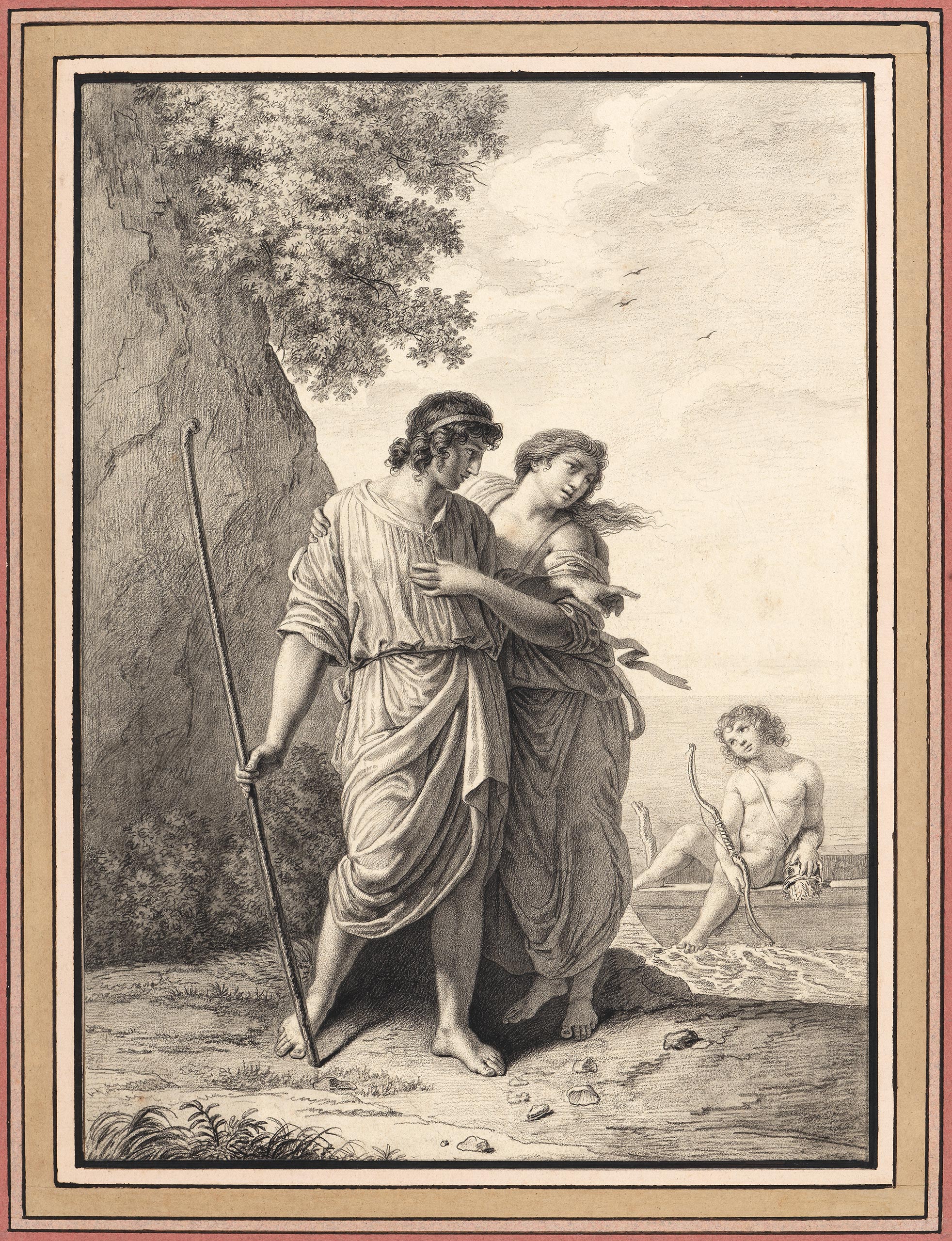
Morghen
Raffaello
Portici 1758 — Firenze 1833
Il Primo Navigatore
Pencil on paper.
In its original mount, made from several strips of coloured paper.
398 x 481 mm (15 11/16 x 18 15/16 in.)
This beautiful sheet is a remarkable addition to the very scarce catalogue of Raffaello Morghen’s graphic production. Best known to the critics for his great activity as an engraver – through which he quickly became one of the most important figures in late-18th-century engraving between Naples, Rome, and Florence – it should be emphasized that the artist’s initial training was rooted in drawing from a young age, thanks to the lessons he received from his father Filippo and uncle Giovanni Elia. Morghen initially devoted himself to producing views of the Neapolitan gulf, where he had grown up1. These early graphic works were so convincing that the French painter Jean-Baptiste Tierce, who was in the Bourbon capital at that time, brought Morghen along with him on his travels in 1775, during which Raphael Morghen portrayed the southern landscape with splendid d’après nature drawings, which ended up in Tierce’s personal collection.2 A few years later, after this experience, the young artist tried his luck in Rome, the capital of the arts and a European cosmopolitan center and entered the workshop of Giovanni Volpato, the undisputed master of engraving, soon becoming his main collaborator.
Also present in the Urbe in the same years was Felice Giani, who had arrived from Bologna where he had studied under Domenico Pedrini and Ubaldo Gandolfi. He seamlessly integrated into the Roman cultural milieu, joining the circle of Angelica Kauffmann, who had recently returned from London, and becoming drawn to the production of Giuseppe Cades, an excellent draughtsman whose brushwork, deeply influenced by Michelangelo and Mannerism, carried a pre-Romantic spirit. A peak of his success within the Roman society was marked by the opening of the Accademia de’ Pensieri in his residence at Palazzo Correa, near the Mausoleum of Augustus. These evening meetings, illuminated by candlelight, involved the creation of drawings on predetermined themes and attracted Italian and foreign artists of renown, such as Domenico Corvi, Giovan Battista dell’Era, Michael Köck and Humbert de Superville3. Contact with Rome also sparked in Giani a growing interest in engraving, a medium that the artist had already experimented with during his years in Pavia, but which found a considerable increase in production in the papal capital, where the number of printers was important. In the years 1781-1782 and 1784-17854, Giani collaborated with Volpato and Morghen on two engravings depicting two scenes from Swiss poet Salomon Gessner’s The First Navigator5, the preparatory plates for which are now preserved at the Istituto Centrale della Grafica in Rome. These are considered ideal pendants to another pair of prints, this time from the paintings of the Swiss artist Johann August Nahl, with the story of Daphne.
The Idylls were enjoying great success throughout Europe and were translated in Italy, where Gessner never went, in Venice in 1777. His uncorrupted pastoral world, characterized by Theocritian lyricism and full of references to the bucolic atmospheres of Virgil, quickly found a positive echo to the pictorial production of artists who had always been close to Arcadian themes; it is no coincidence that the Accademia dell’Arcadia was founded in Rome, an important institution that dictated the cultural line for over a century.
Felice Giani was asked several times to treat the theme of The First Navigator: first in a small canvas now in the Pinacoteca di Bologna; then in the house of the Bolognese doctor and lecturer Gaetano Conti, where he was called upon in 1810 to decorate the ceiling with octagons that fit harmoniously into the wooden framework; but most notably in the pharaonic rooms of the Spanish Embassy building at the Holy See in Rome’s central Piazza di Spagna in 1806,6 where Giani’s brushwork reaches unprecedented heights, of which the ceiling oils on paper are the most splendid example.
Our drawing depicts the moment when the maiden joins the First Sailor. It is to be considered preparatory to the print (Fig. 1) which is in reverse and in oval form and bears the Latin signature ’Felix Gianni pinxit’, and reads in the lower part ’Miran l’informe barca e il mar che freme – Ma non miran più i loro i loro begli occhi – Quand’anno appreso a vagheggiarsi insieme’ (“They gaze upon the formless boat and the trembling sea – But their beautiful eyes see nothing more – Once they have learned to gaze upon each other together”). In the center of the sheet, the young sailor, dressed in classical style and holding a stick, points out to the young girl, whose hair and dress ribbons are swaying in a graceful wind, the boat that placidly approaches the shore. A cupid, in heroic nudity, is seated on board with quiver and bow. The scene seems to take place on the unspoiled beaches of Ellas; on the left, as if in a theatrical setting, a lush bush clings to a rock, while, on the right the sky opens up, barely coloured by light clouds and animated by birds in flight.
For its calibrated composition, elegant and calm stroke, with light shading, this sheet seems very close to the graphic production of the classicist painters, mindful of the lessons of Carlo Maratta, among them Stefano Pozzi, in particular the blue papers of excellent quality depicting Apollo and Daphne in the Kunstpalast in Düsseldorf or Venus and Aeneas in the Metropolitan Museum of Arts in New York, Giuseppe Botani and Giacomo Zoboli, whose drawings in the Morgan Library7 are worth mentioning, without forgetting the indispensable lesson of an absolute master such as Pompeo Batoni.
To confirm the attribution to the refined hand of Raphael Morghen, it is useful to compare our drawing to the drawing auctioned by Sotheby’s depicting a copy of Raphael’s Prophet Isaiah in the church of Sant’Agostino (Fig. 2).8 It is highly probable that this sheet, characterised by an extremely precise and refined stroke, is a testimony to the study of the great masters of the Italian Renaissance carried out once Morghen arrived in Urbe. Our drawing, still in the splendid original mount with which it was probably exhibited, adds a fundamental piece in the critical reconsideration of an artist who should be known not only for his engraving activity, but also for his great talent in drawing, of which all the sources attest.
Lorenzo Giammattei
- “Il di lui genio, e trasporto particolare, era quello di disegnar Paesi, nel che indefessamente esercitandosi a matita e ad acquerello, giunse persino a dipingerne a olio” (“His genius and particular inclination were toward drawing landscapes, in which he tirelessly practiced with pencil and watercolor, eventually even painting them in oil” in N. Palmerini, Catalogho delle Opere d’Intaglio di Raffaello Morghen, Firenze, 1810, p. 8.
- “Il valente paesista Batista Tierce, conosciuto a prova il genio del giovane portato pel detto studio, conducealo seco in campagna, dove disegnò moltis- sime vedute, che quasi tutte restarono presso il sopracennato Pittore, il quale gran piacere provava nel coltivare il bel talento di Raffaele” (“The skilled landscape artist Giovanni Battista Tierce, recognizing the genius of the young artist gifted for this study, took him out to the countryside, where he drew numerous views, almost all of which remained with the aforementioned painter, who greatly enjoyed nurturing Raffaele’s beautiful talent”) in Palmerini, op.cit., p. 10.
- For a more complete insight into the history of the Accademia de’ Pensieri, see L’Officina Dall’Accademia de’ Pensieri all’Accademia d’Italia, catalogo della mostra a cura di Francesco Leone (Faenza, Palazzo Milzetti 15 March-21 June 2009), Silvana Editoriale, Milan, 2009.
- A. Scoti, M. Vitali, Felice Giani. Artista anticonvenzionale tra fascino dell’antico e tensioni preromantiche. San Sebastiano Curone, Sagep Editori, Geneva 2023, p. 71-72.
- “ The preparatory plates for the two engravings of The First Navigator are kept in the collections at the Central Institute for Graphics in Rome and measure 420×324 mm.
- A. Ottani Cavina, Felice Giani e la cultura di fine secolo, Mondadori Electa, Milan, 1999, p. 578.
- See the drawings depicting the Two Angels with a classical head study on the verso (Inv. 1988.4) or the preparatory drawing for the figure of Christ (Inv. 1986.9, gift of Marcello Aldega and Margot Gordon) in the altarpiece with the Ecstasy of St. Clare of Montefalco.
- Sotheby’s London, Old Master Drawings including the Castle Howard Michelangelo, 11 July 200, lot 269.

